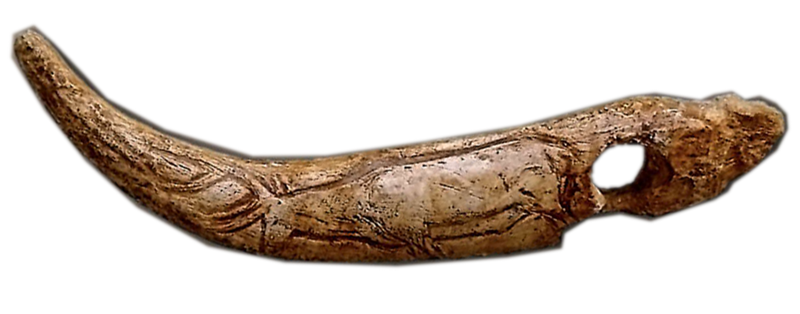The Cave of El Castillo is one of several caves containing Palaeolithic art in the municipality of Puente Viesgo in Cantabria, Spain, situated some 20km southeast of the more famous cave at Altamira. Discovered in 1903 by Hermilio Alcalde de Río, the cave contains several chambers in which friezes of paintings are located, and there is evidence to suggest the cave was in intermittent usage from the Auriginacian until as late as the Bronze Age, and that during the Magdalenian may have formed, along with Altamira and other nearby caves, the core territory of a single human group. Indeed, there are several smaller Palaeolithic painted caves within the same mountain as El Castillo, and the area may have formed a key pilgrimage or sacred site for this group.
|
Palaeolithic Cave Art in Europe is celebrated as a profound expression of deft visionary and naturalistic skill. Once thought to have emerged fully-formed some 28,000 years ago, modern dating techniques and new discoveries are revealing the developmental processes of these artforms from simple dot and line compositions to the more skilfully-rendered friezes at Chauvet, Altamira, Lascaux and others, while at the same time showing that the majority of the art was created in three discrete periods, the early-to-mid Aurignacian (33-28 kYa B.P.), the mid-to-late Gravettian and early Solutrean (24-21 kYa B.P.) and the Magdalenian (18-12 kYa B.P.) with minimal surviving cave art activity between these times. The varied but simplistic art seen in El Castillo cave, Cantabria, Spain, generally belongs to the first two of these periods, but a recent uranium-series dating on one petroglyph dated it to almost 41,000 years, making it the oldest known cave art in Europe.
The Cave of El Castillo is one of several caves containing Palaeolithic art in the municipality of Puente Viesgo in Cantabria, Spain, situated some 20km southeast of the more famous cave at Altamira. Discovered in 1903 by Hermilio Alcalde de Río, the cave contains several chambers in which friezes of paintings are located, and there is evidence to suggest the cave was in intermittent usage from the Auriginacian until as late as the Bronze Age, and that during the Magdalenian may have formed, along with Altamira and other nearby caves, the core territory of a single human group. Indeed, there are several smaller Palaeolithic painted caves within the same mountain as El Castillo, and the area may have formed a key pilgrimage or sacred site for this group.
3 Comments
The figure of Europa, and her abduction by Zeus, is considered by many to be the founding myth of Europe – indeed the Phoenician queen lent her name to the continent. A careful teasing apart of the strands of the myth, however, reveal a Pre-Greek deity whose form may be reflected in Minoan iconography: the 'Goddess from the Sea' often seen in images of the Epiphany and other religious contexts. This essay is excerpted and expanded from two sources: my treatise The Minoan Epiphany: A Bronze Age Visionary Culture, an ongoing work-in-progress, and Europa Untouched, a set of research notes for my 'Minoan Honey' series.
Classical Greek mythical traditions are a fascinating fusion of elements springing from both Proto-Greek and Indo-European, as well as Mesopotamian and Anatolian cultures. But one of the strongest currents running through the various traditions originates from the Pre-Greek aboriginal inhabitants of the Aegean, of whom the Minoans were probably the most well-known. A vast array of mythforms and deity names have a profound Pre-Greek flavour, and none more so than the story of Europa. |
ARCHAIC VISIONS
|





 RSS Feed
RSS Feed






